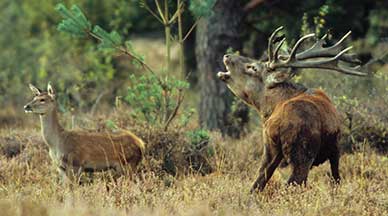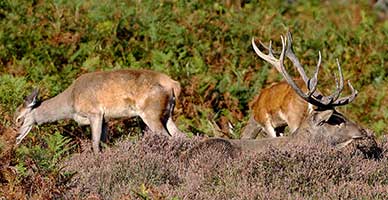New Forest Red deer - identification and behaviour
How many: Around 125 - 180 red deer are present. Together with sika deer, red deer are the least abundant of the relatively commonly seen New Forest deer.
Herds: In favoured areas, hinds sometimes gather in large herds of up to 50, or more, animals. In late summer and during the subsequent rut, typically in the same places each year, hinds are joined by a smaller number of stags.
Size: Britain's largest land mammal. Weight as much as 190 kilos (420 lbs). Up to 105-140 centimetres (41-54 inches) at the shoulder. Stags are larger than hinds. Quite bulky, square-jawed face.
Coat: Summer coat is a dark or sandy red/brown. In winter, dark brown/grey. Adults usually have no spotting; calves are white spotted. Stags develop a thick, dark mane for the rut.
Rear end: Usually paler than the body colour with a quite broad, sandy brown, tapering tail, with little contrasting colour.
Antlers: Long, cylindrical, multi-pointed.
Sounds: A year-round cough-like bark. Stags roar during the rut - a sound almost like a cow’s ‘moo’, but of considerably deeper tone.
The annual rut

Red deer are often surprisingly confiding, content to stand and stare whilst intruders pass by, before casually wandering away. But early on autumnal mornings, during the annual rut, testosterone charged stags with thickened manes make a fearsome sight as, muscles rippling, flanks caked in mud, breath billowing white against the darker heather, they roar their welcome to the dawn.
The biggest stags have the finest antlers, or heads, as they are often known, with sometimes as many as 20 sharp, burnished points. Each is a potential weapon in the fight for supremacy, the battle for matings with the hinds. Fights between stags, though, are infrequently witnessed. More often sound, display, posture and chase are sufficient to settle disputes.
Unlike fallow bucks that try to attract females to a rutting stand, red deer stags have less allegiance to a piece of ground, much preferring to try to control the movements of a chosen group of hinds.
When engaged in this high energy task, the stags are rarely still, sometimes running, sometimes walking, often slowly, deliberately pacing, but always with obvious intent – to bring wandering hinds back into the fold, and, of course, should the need arise, to drive off competitors.
Yearling stags, those with single spikes for antlers, often hang around the edge of the group, jousting amongst themselves, preparing for the day when they too will hold a group of hinds. Providing that they do not get too close, presence is often tolerated, but encroaching animals are chased away, only to return a little later when the resident, mature stag’s back is turned.
Noise, action, aggression: this is wildlife in the raw.

But the big stags are not always in as much control as they might like to think, for sometimes, whilst he roars and prances, the hinds, led by an elder bored of the whole process, simply wander off. Then, the largest beast in the New Forest may try to round them up again, or sometimes, head bowed, meekly follows on.
By mid to late-morning, rutting activity usually quietens, and the deer settle in the heather, content to lie-up for the remainder of the day. Out on open heaths, they can be particularly inconspicuous for such large animals. Antlers protruding from the tall, rank vegetation; ears occasionally twitching, stags and hinds relax together, waiting for the next day’s dawn for action to start again.
Food, though, can distract even the most amorous of red deer, for sometimes, particularly during years with abundant beech mast and acorns, the start of rutting is delayed as the animals remain in the woods, mopping up the harvest. Similarly, after an initial frenzied burst of activity, red deer rutting sometimes subsides for a number of days, only to resume again after appetites have been sated. It’s clearly all a question of priorities!
Outside the rutting season, a high proportion of hinds stay in, or close to traditionally favoured areas, though some are compulsive wanderers, appearing from time to time considerable distances away then just as quickly disappearing. Many of the stags, though, in bachelor groups, leave the New Forest altogether after the rut, re-appearing only ready for the on-set of the following year’s festivities.
New Forest deer - find out lots more
References:
The History of British Mammals: Derek Yalden
Deer Watch: Richard Prior
New Forest Roe deer: John K. Fawcett
Roe deer: John K. Fawcett
Sika deer: Rory Putman
Fallow deer: Jochen Langbein and Norma Chapman
More links
Other related links
Search this site

Sadly, 58 animals were killed - 35 ponies, 13 cows, 8 donkeys and 2 sheep, whilst a further 32 were injured - 3 pigs, 9 donkeys, 11 cows and 9 ponies.
(Forty-three accidents occurred in daylight, 15 at twilight and 101 in the dark. Twenty-seven accidents were not reported by the driver involved).
Here's just one horrific example - Three donkeys killed in collision with van at notorious New Forest blackspot (Advertiser and Times)

